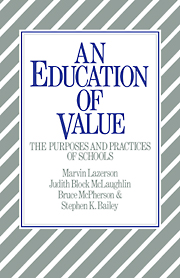Chapter 3 - Equality and inequality
Published online by Cambridge University Press: 05 June 2012
Summary
The challenge to American education is to be both equal and excellent. Unless we seek equality, we undermine the possibility of achieving the excellence that comes when all students fulfill their learning capacities. Unless we seek excellence, our notion of equality will be barren, for it will lack a commitment to quality. Achieving equality and excellence involves providing opportunities so that each student can do his or her best, succeed at something worthwhile, and take pride in that accomplishment. This is probably as close as we can get to an educational “right.”
In the twentieth century, we have tended to focus on either equality or excellence. The period of curricular reform of the 1950s and 1960s, when the predominant concern was for excellence in education, was followed by a period of emphasis on equality of educational opportunity. Blacks, whites, and Hispanics formed coalitions to fight for the equalization of school financing, the integration of schools, the provision of compensatory education, and the introduction of English as a second language (ESL) and other special-need programs. They sought equality of access and treatment for those groups of students previously denied the full benefits of the American educational system.
In the 1980s, the call once again is for excellence in education. Many Americans now believe that the efforts to create a more egalitarian educational system were made at the expense of quality. Some believe that liberalizing the curriculum to serve a plurality of interests resulted in a permissiveness that converted learning into playing and “doing one's own thing.”
- Type
- Chapter
- Information
- An Education of ValueThe Purposes and Practices of Schools, pp. 49 - 62Publisher: Cambridge University PressPrint publication year: 1985

